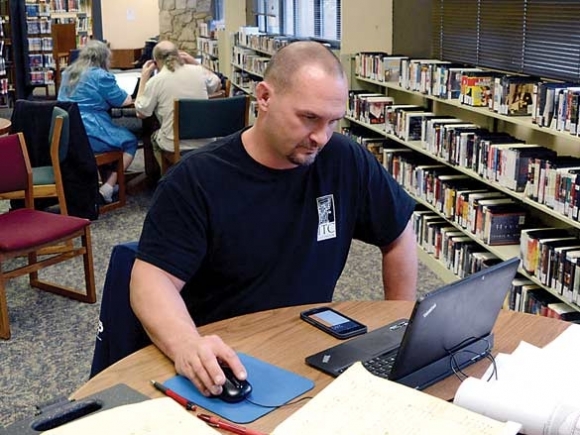Public input will guide library’s renovation

An ambitious dream of expanding and remodeling the main Haywood County library in Waynesville has been abandoned, with sights now set on a renovation plan to improve and upgrade the library within the existing footprint.
A strategic library task force is seeking public input on the latest version of a master plan with a series of public input meetings over the next two weeks — one at each of the four library branches in the county.
“We really hope the public will come forward. We want to know, as you look at the future of your library for Haywood County, what kinds of things you want to see,” said County Manager Ira Dove.
A committee of library supporters spent two years crafting a vision for a $6 million expansion and renovation of the Waynesville library. However, the expansion plan was largely dead on arrival.
“We had to completely put that on the back burner. It just wasn’t in the cards,” said David Felmet, chair of the library’s strategic planning task force.\
SEE ALSO: Haywood County Library Strategic Plan
Related Items
County leaders last fall launched a new strategic planning process with a more holistic view of improving library services countywide that was less focused on expanding the footprint of the Waynesville library. The public feedback thus far still points to the need for more space, but county leaders believe improvements can be achieved through renovations.
While it’s not what library advocates hoped for, Felmet hopes the renovations will come to fruition.
“We play with the hand we’re dealt,” he said. “The expansion, that’s off the table. But we are hoping maybe to get some funding to upgrade the building.”
Built in 1980, the Waynesville library is not only tired and dated, but is no longer adequate to meet the growing population of Waynesville or the modern expectations of a library, Felmet said.
Dove said the new strategic planning process is examining “what is best for the system as a whole, which includes all branches — Canton, Fines Creek, Maggie Valley and Waynesville.”
Dove said county commissioners realize how important the library is to the public.
“Most citizens have a library card,” Dove noted.
County hits the reset button
The grand $6 million expansion plan for the Wayensville library failed to gain traction last year from county commissioners — the ones who hold the purse strings to make the project happen or not.
The plan went over like a lead balloon when library advocates presented it to commissioners at a county budget workshop over a year ago. Commissioners were visibly taken aback by the slick foam board posters depicting floor plans for a bigger and better library.
County leaders called for a do-over of the planning process, questioning the conclusion that an expansion was the only path forward.
The initial master plan had been two years in the making. Library patrons weighed in with surveys and input meetings, conveying what they wanted to see in their future library. A consultant was hired to analyze library services and facilities — paid for with funding from the non-profit library support groups. And an architect was hired to sketch out a conceptual rendering of the expansion.
The work was mostly tossed out, however.
Last fall, a new county-sanctioned library task force was named, and the work of crafting a strategic plan for the library’s future started over — this time, with county officials taking the lead.
So far, the county is still replicating the first step: public input. The initial planning process had gathered 700 surveys from among library users, but since it only targeted active library users, the responses came from a slanted demographic. More than 70 percent of survey respondents were women, 65 percent had four-year college degrees or higher and only 5 percent of responding adults had no college at all.
County officials felt that it was more representative and less biased to survey a sample of the general public at large, rather than only surveying library patrons.
So the county commissioned a new survey, this time designed and conducted by the Western Carolina University Public Policy Institute. The survey was mailed to a cross-section of residents, with 718 responses received.
It was an impressive showing, and achieved the county’s goal of ensuring that the strategic plan moved forward with “as much feedback as possible,” Dove said.
The surveys
Both sides believe the evidence gathered from public surveys and focus groups points to their own conclusion.
Library supporters who want to make the Waynesville flagship library bigger and better point to the public surveys as justification that an expansion and renovation is warranted to meet modern demands and expectations.
“We have gone around and around in this building trying to figure out how it could be better without expanding it,” said Sharon Woodrow, Haywood County Library Director.
Woodrow said the library will certainly take what it can get, but in her opinion, the Waynesville library branch is simply not big enough and remodeling will fall short.
“I don’t feel like it is large enough now to accommodate the services we have currently,” she said. “Of course, upgrading it will make it better. It will just not make it the building that will grow into what we need now and in the future.”
But county leaders who oppose the price tag of an expansion point to the surveys and focus group results as evidence that the library only needs remodeling to meet the public’s needs.
“We got a lot of input with the surveys and thoroughly went through it all to see what the real needs are,” said County Commissioner Chairman Kirk Kirkpatrick, who serves as a county liaison on the library board.
Kirkpatrick said the public input shows improvements are needed, but doesn’t point to a clear need for a $6 million expansion of the Waynesville library footprint.
“That is certainly disappointing to some folks,” Kirkpatrick sympathized. “But that’s what I deal with all the time. Somebody is always going to be disappointed. It is a balance between what we want and what we need and if we have the money to do it.”
However, Woodrow questions that conclusion.
“The survey was meant to speak for the system and did not ask questions about individual libraries,” Woodrow said. “The survey concluded that the public wants a larger collection, additional hours, more programs, quiet spaces and upgraded computers and internet. In order to provide most of these requests, the library will more than likely need additional space to accommodate them.”
What’s next?
Library users are being encouraged to participate in a series of public input meetings over the next two weeks. County officials want feedback on the new strategic plan — which replaces the original expansion plan — before taking it to county commissioners for an endorsement.
The strategic plan does not get into specifics, but rather focuses on overarching goals and priorities. Those goals would in turn guide the creation of a more specific master plan.
“Then the real decision-making begins for our library system,” Woodrow said.
Presumably, if the strategic plan is approved by commissioners, the next step would be hiring a consultant to develop a renovation plan to repurpose how space is used and allocated in the Waynesville library.
However, in the meantime, Dove said library staff would be engaged in an analysis of short-term measures and fixes that could address immediate goals.
“The next thing is for staff to put pen to paper on what is going to be achievable in the next year and the year after,” Dove said.
Modern technology is one of the biggest deficits identified in the strategic plan. The library was built in a pre-internet era, but it has increasingly become a hub for computer and internet access.
“Our computers are old and our hardwired stations are not adequate,” Felmet said.
The library also serves as a hotspot for people who don’t have high-speed internet access at home.
“If you live in a dark cove in the county, and need to get online at 2 in the morning, you can drive to the library and use the internet service in the parking lot,” Felmet said.
But better workstations are needed to accommodate the large volume of people camping out at the library for internet access during the day.
Another top request from the public has nothing to do with space or facilities. The public wants expanded library hours. Evening hours are currently limited — with the library open only until 6 p.m. three days a week, and never past 7 p.m. The Waynesville library is open for only six hours Saturday and not at all Sunday. Meanwhile, the Canton library is open limited hours on Sunday, but not at all on Saturday.
During the recession the library’s budget was cut and staffing was reduced, requiring hours to be curtailed. The library’s budget has remained largely stagnant since, even though county finances have improved in recent years. However, most county departments are still operating on less than they were before the recession, Dove pointed out.
“They are all playing with fewer players since the recession,” Dove said.
The library saw a modest budget increase last year, with another in the cards this year. It’s not enough to restore staffing levels, but will hopefully improve the situation some.
The Waynesville library is now the oldest and most dated county facility. Over the past 15 years, the county has systematically replaced or renovated nearly every county building, facility and office.
The county built a new justice center, new jail, new sheriff’s office, new dispatch center, new emergency services base, new health and human services department, new election office, new senior center, new animal shelter, new planning and building department, plus renovated county offices in the historic courthouse.
The library system is now the next on the list, but what, if any, renovations are tackled will ultimately depend on the level of public support the county detects.
“There is still much to be done. Together we can build on this excellent system and shape its future,” Dove said.
Woodrow, who reports to Dove, has gone out on a limb by speaking out in favor of an expansion, even though it’s not what county leaders appear to want. Woodrow plans to retire in September, and is trying to remain positive in the meantime.
“I have to put my faith into the commissioners to come up with a plan that will help solve this problem and carry the library into the future,” Woodrow said.
Take-aways from the library survey
A survey targeting a broad cross-section of the general population in Haywood County was conducted in late winter by the WCU Public Policy Institute on behalf of Haywood County. More than 700 respondents answered a wide variety of questions about their library usage and the library amenities and programs that are important to them.
Here’s some of the results:
56 percent support additional public funding, including a tax increase, to improve the library system.
The top five improvements respondents wanted to see are: bigger collections (54 percent), expanded hours (42 percent), more adult programs (27 percent), additional quiet spaces for reading and studying (25 percent) and better technology (18 percent).
Among respondents who use the library, 18 percent said they use the library daily, 29 percent use it weekly and 28 percent use it occasionally.
25 percent of respondents reported that they never use the library. Their reasons were: no need for the library (35 percent), inconvenient hours (28 percent) and insufficient collections (17 percent).
Weigh in
The following public input meetings are designed to gather feedback on a strategic plan for improving the Haywood County library system.
Fines Creek Library: 2 p.m. Monday, June 19
Canton Library: 5 p.m. Monday, June 26
Maggie Valley Library: 2 p.m. Tuesday, June 20
Waynesville Library: 4 p.m. Tuesday, June 27









